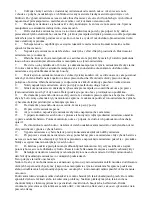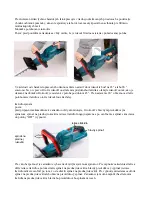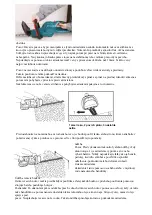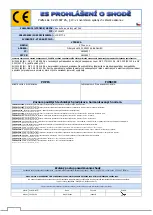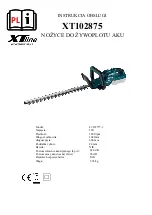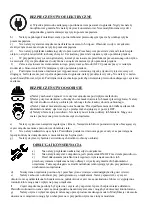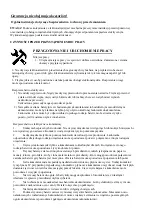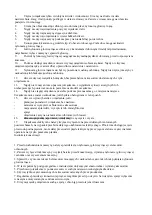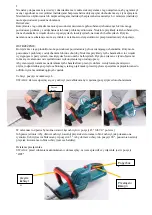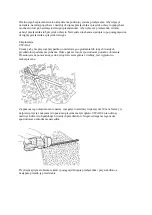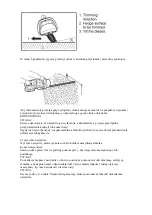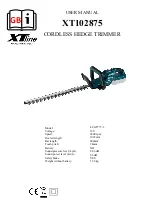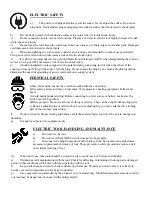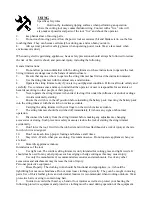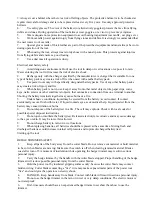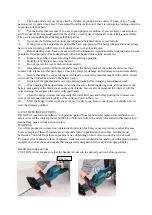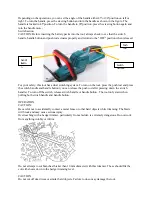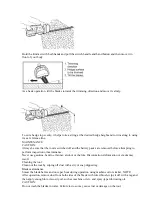
3. Always wear a helmet where there is a risk of falling objects. The protective helmet is to be checked at
regular intervals for damage and is to be replaced at least every five years. Use only approved protective
helmets
4.
Use safety glasses. The visor of the helmet (or alternatively goggles) protects the face from flying
debris and stones. During operation of the tool always wear goggles, or a visor to prevent eye injuries.
5.
Wear adequate noise protection equipment to avoid hearing impairment (ear muffs , ear plugs etc.).
6.
Work overalls protect against injury from flying stones and debris. It is strongly recommended that
the user wears work overalls.
7.
Special gloves made of thick leather are part of the prescribed equipment and must always be worn
during operation of the tool.
8.
When using the tool, always wear sturdy shoes with a nonslip sole. This protects against injuries
from flying debris and ensures a good footing.
9.
Use a dust mask if operation is dusty.
Electrical and battery safety
1.
Avoid dangerous environment. Don't use the tool in damp or wet locations or expose it to rain.
Water entering the tool will increase the risk of electric shock.
2.
Recharge only with the charger specified by the manufacturer. A charger that is suitable for one
type of battery pack may create a risk of fire when used with another battery pack.
3.
Use power tools only with specifically designated battery packs. Use of any other battery packs
may create a risk of injury and fire.
4.
When battery pack is not in use, keep it away from other metal objects, like paper clips, coins,
keys, nails, screws or other small metal objects, that can make a connection from one terminal to another.
Shorting the battery terminals together may cause burns or a fire.
5.
Under abusive conditions, liquid may be ejected from the battery; avoid contact. If contact
accidentally occurs, flush with water. If liquid contacts eyes, seek medical help. Liquid ejected from the
battery may cause irritation or burns.
6.
Do not dispose of the battery(ies) in a fire. The cell may explode. Check with local codes for
possible special disposal instructions.
7.
Do not open or mutilate the battery(ies). Released electrolyte is corrosive and may cause damage
to the eyes or skin. It may be toxic if swallowed.
8.
Do not charge battery in rain, or in wet locations.
9.
When replacing batteries, all batteries should be replaced at the same time. Mixing fresh and
discharged batteries could increase internal cell pressure and rupture discharged battery(ies).
Starting up the tool
HEDGE TRIMMER SAFETY
1.
Keep all parts of the body away from the cutter blade. Do not remove cut material or hold material
to be cut when blades are moving. Make sure the switch is off when clearing jammed material. Blades
coast after turn off. A moment of inattention while operating the hedge trimmer may result in serious
personal injury.
2.
Carry the hedge trimmer by the handle with the cutter blade stopped. Proper handling of the hedge
trimmer will reduce possible personal injury from the cutter blades.
3.
Hold the power tool by insulated gripping surfaces only, because the cutter blade may contact
hidden wiring. Cutter blades contacting a "live" wire may make exposed metal parts of the power tool
"live" and could give the operator an electric shock.
4.
DANGER - Keep hands away from blade. Contact with blade will result in serious personal injury.
5.
Do not use the hedge trimmer in the rain or in wet or very damp conditions. The electric motor is
not waterproof.
6.
First-time users should have an experienced hedge trimmer user show them how to use the
trimmer.

